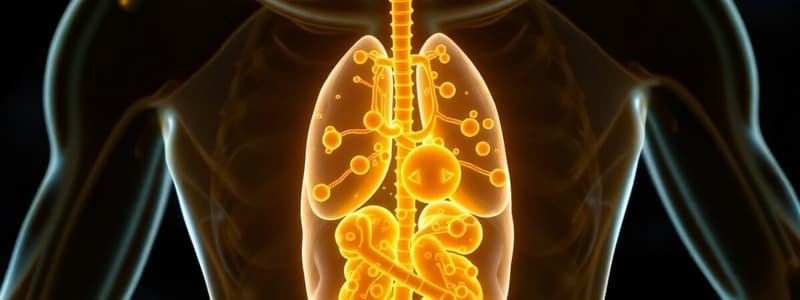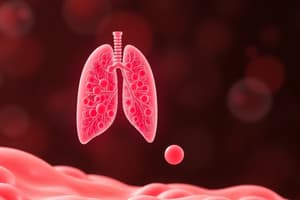Podcast
Questions and Answers
What is the net gain of ATP produced during glycolysis?
What is the net gain of ATP produced during glycolysis?
- 4 ATP
- 2 ATP (correct)
- 0 ATP
- 38 ATP
Anaerobic respiration produces more ATP than aerobic respiration.
Anaerobic respiration produces more ATP than aerobic respiration.
False (B)
Name one end product of lactic acid fermentation in animals.
Name one end product of lactic acid fermentation in animals.
Lactic acid
Glycolysis occurs in the ______ of the cell.
Glycolysis occurs in the ______ of the cell.
Match the following types of respiration with their characteristics:
Match the following types of respiration with their characteristics:
Flashcards are hidden until you start studying
Study Notes
Anaerobic Respiration
Glycolysis Process
- Definition: Glycolysis is the first step in both aerobic and anaerobic respiration. It breaks down glucose to produce energy.
- Location: Occurs in the cytoplasm of the cell.
- Stages:
- Energy Investment Phase: Requires 2 ATP to convert glucose into fructose-1,6-bisphosphate.
- Cleavage Phase: Six-carbon sugar is split into two three-carbon molecules (glyceraldehyde 3-phosphate).
- Energy Payoff Phase: Each three-carbon molecule is converted to pyruvate, yielding a net gain of 2 ATP and 2 NADH.
- Net Gain:
- 2 ATP (net gain, 4 produced, 2 used)
- 2 NADH
- 2 Pyruvate molecules
Anaerobic Vs Aerobic Respiration
-
Definition:
- Anaerobic Respiration: Energy production in absence of oxygen, resulting in fermentation.
- Aerobic Respiration: Energy production with the presence of oxygen, leading to complete oxidation of glucose.
-
Process:
- Anaerobic:
- Glycolysis followed by fermentation (e.g., lactic acid fermentation in animals, alcoholic fermentation in yeast).
- Produces a small amount of ATP (2 ATP per glucose).
- Aerobic:
- Glycolysis followed by the Krebs cycle and oxidative phosphorylation.
- Produces a larger amount of ATP (up to 36-38 ATP per glucose).
- Anaerobic:
-
End Products:
- Anaerobic:
- Lactic acid (in muscles) or ethanol and carbon dioxide (in yeast).
- Aerobic:
- Carbon dioxide and water.
- Anaerobic:
-
Usage:
- Anaerobic: Used by organisms in low oxygen environments or during short bursts of activity (e.g., intense exercise).
- Aerobic: Preferred by most multicellular organisms for efficiency and energy yield.
-
Efficiency:
- Anaerobic respiration is less efficient than aerobic respiration in terms of ATP production per molecule of glucose.
-
Organisms:
- Anaerobic: Some bacteria, yeast, and muscle cells in humans.
- Aerobic: Most higher organisms, including humans.
Glycolysis
- Breaks down glucose to produce energy
- Occurs in the cytoplasm of the cell
- Requires 2 ATP in the energy investment phase
- Cleavage phase splits a six-carbon sugar into two three-carbon molecules
- Energy payoff phase yields a net gain of 2 ATP and 2 NADH per glucose molecule
Anaerobic Respiration
- Produces energy in the absence of oxygen
- Follows glycolysis, then enters fermentation
- Two main types: Lactic acid fermentation and Alcoholic fermentation
- Yields a small amount of ATP (2 ATP per glucose)
- Utilized by organisms in low oxygen environments and during short bursts of intense exercise
Aerobic Respiration
- Requires oxygen for energy production
- Begins with glycolysis, followed by the Krebs cycle and oxidative phosphorylation
- Yields a larger amount of ATP (36-38 ATP per glucose)
- Produces carbon dioxide and water as end products
- The preferred energy production method for most multicellular organisms
Key Differences between Anaerobic and Aerobic Respiration
- Oxygen requirement: Anaerobic respiration does not require oxygen, while aerobic respiration does.
- ATP Production: Aerobic respiration produces significantly more ATP than anaerobic respiration.
- End Products: Anaerobic respiration produces lactic acid or ethanol and carbon dioxide, while aerobic respiration produces carbon dioxide and water.
- Efficiency: Aerobic respiration is more efficient than anaerobic respiration in terms of ATP production per glucose molecule.
Studying That Suits You
Use AI to generate personalized quizzes and flashcards to suit your learning preferences.





